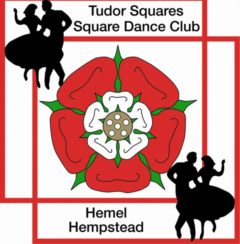Basic Movements Definitions Part 1 No.11 – 21
 |
. . 11. Half Sashay Family | |
|---|---|---|
| People Involved | 2 dancers | |
| START | couple | |
| END | couple | |
| Movement | (a) HALF SASHAY: Partners exchange places without changing facing directions. Dancer on the right sidesteps to the left, while the other dancer on the left steps back, sidesteps to the right, then steps forward to rejoin partner. (b) ROLLAWAY: The directed dancer, or if not specified the dancer on the right, rolls across a full turn (360。) in front of the dancer on the left, as he sidesteps to the right -to exchange places. From a circle, unless otherwise directed, the ladies roll left across in front of the men. (c) LADIES IN, MEN SASHAY: Starting formation -circle or line with alternating men and ladies. With all dancers facing in, the ladies step forward and pause, while the men move to the left behind and past one lady. Ladies step back and rejoin hands with the men. If the circle is moving to the right, the men sashay to the right. |
|
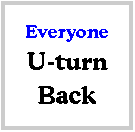 |
. . 12.Turn Back Family | |
|---|---|---|
| People Involved | single dancer | |
| START | anywhere | |
| END | same but looking opposite direction | |
| Movement | (a) U TURN BACK: The dancer does an in-place about-face turn (180。), turning toward partner unless the body flow dictates otherwise. If alone (i.e. no partner), the dancer turns toward the center of the set. If the dancer is facing directly toward or away from the center of the set, he may turn in either direction. (b) GENTS OR LADIES BACKTRACK: The dancer does a U turn back by stepping out and turning away from partner or the center of the set. |
|
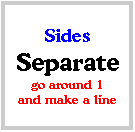 |
. . 13.Separate | |
|---|---|---|
| People Involved | 2 dancers | |
| START | couple | |
| END | depends on the call | |
| Movement | The dancers in the couple turn back to back with each other and walk forward around the outside of the square. The distance traveled is determined by the next call. | |
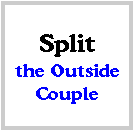 14. Split Two 14. Split Two |
||
|---|---|---|
| People Involved | 4 dancers | |
| START | facing couple | |
| END | back to back couple | |
| Movement | he active or directed couple moves forward between the outside couple who sidesteps slightly to let them through then sidesteps back together again. | |
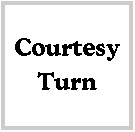 |
. . 15. Courtesy Turn | |
|---|---|---|
| People Involved | 2 dancers | |
| START | couple, facing dancers. (Limited at Mainstream to couples with man on left, woman on right.) | |
| END | same but facing opposit direction | |
| Movement | The man (left hand dancer) takes the lady’s (right hand dancer) left hand (palm down) in his left (palm up) and places his right hand in the small of the lady’s back. Working as a unit, the couple turns around with the left hand dancer backing up and right hand dancer walking forward. Unless otherwise specified, the couple faces the center of the set or the center of the formation in which it is working. | |
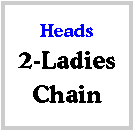 |
. . 16. Ladies Chain Family | |
|---|---|---|
| People Involved | 4 or 8 dancers | |
| START | Ladies Chain: facing couple Couple Chain Down the Line: RH-2-Faced Line, LH-Wave |
|
| END | facing couple | |
| Movement | (a) TWO LADIES CHAIN: The ladies step forward, extend right hands to each other and pull by. Each man steps forward and to the right, turning left to face the same direction as the lady beside him. The lady extends a left hand to the man for a courtesy turn. Couples end facing each other. (b) FOUR LADIES CHAIN: Starting formation -square or circle of 8 dancers. Similar to two ladies chain except that all four ladies step to the center and form a right hand star. They turn the star halfway around to their opposite men. All courtesy turn to face the center of the set. NOTE: TWO (or FOUR) LADIES CHAIN THREE QUARTERS: Starting formation -facing couples, a square or circle of 8 dancers. The directed ladies step to the center, form a right hand star and turn the star three quarters. All courtesy turn to face the center of the set. (c) CHAIN DOWN THE LINE: From a right hand line or left hand ocean wave, centers trade while ends adjust as necessary. Then the ends courtesy turn the centers. Ending formation is facing couples. |
|
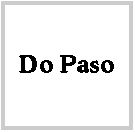 |
. . 17. Do Paso | |
|---|---|---|
| People Involved | 4 or 8 dancers | |
| START | square or circle | |
| END | square or circle | |
| Movement | Each dancer faces partner or directed dancer and does a left arm turn half (180。) to face in the opposite direction. Releasing armholds and moving forward, each dancer goes to the corner for a right arm turn half (180。). Each returns to the starting partner to courtesy turn to face the center of the set or to follow the next call. | |
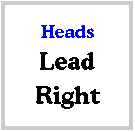 |
. . 1 18. Lead Right | |
|---|---|---|
| People Involved | 2 dancers | |
| START | couple | |
| END | couple | |
| Movement | Directed couple(s) take a step forward, and as a unit turn to the right 90。 and move forward. | |
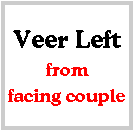 |
19. Veer Left / Veer Right | |
|---|---|---|
| People Involved | 2 or 4 dancers | |
| START | 1)facing couple or facing dancers 2)2-faced line or mini wave |
|
| END | 1)2-faced line or mini wave 2)back to back |
|
| Movement | Two facing couples working as a unit, or two facing dancers move to the left (or right, as directed) and forward to end in a two-faced line or mini wave respectively. From a mini wave or a two-faced line, the veering direction must be toward the center of the mini wave or line. Each dancer, or couple working as a unit, moves forward and inward to end back to back with the other dancer or couple respectively. | |
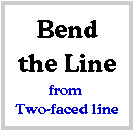 |
20. Bend the Line | |
|---|---|---|
| People Involved | 4 dancers | |
| START | 2-faced line or 1-faced Line | |
| END | facing couple | |
| Movement | The center dancers in the line drop hands with each other. With each half of the line working as a unit, the ends move forward while the centers back up until both halves of the line are facing. | |
 |
21. Circulate Family | |
|---|---|---|
| People Involved | all 8 = 8 dancers / split = 4 dancers | |
| START | waves, columns, lines and two-faced lines | |
| END | various | |
| Movement | GENERAL RULE: Directed (active) dancers move forward along the circulate path to the next position. The circulate paths for various formations are indicated by the dotted lines in the diagrams. (a) BOYS CIRCULATE, (b) GIRLS CIRCULATE, (c) ALL EIGHT CIRCULATE, (d) ENDS CIRCULATE, (e) CENTERS CIRCULATE: Directed dancers circulate using the general rule. (f) COUPLES CIRCULATE: Starting formation -lines or two-faced lines. Each couple, working as a unit, moves forward along the circulate path to the next position, using the general rule. (g) BOX CIRCULATE: Starting formation -box circulate. Each dancer moves forward along the circulate path to the next position, using the general rule. (h) SINGLE FILE CIRCULATE (COLUMN): Starting formation -columns. Each dancer moves forward along the circulate path to the next position, using the general rule. (i) SPLIT CIRCULATE: Starting formation -lines, waves or columns. The formations divide into two separate boxes and dancers circulate within their own foursome, using the general rule. |
|
